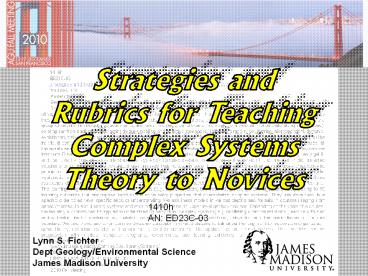Lynn S. Fichter - PowerPoint PPT Presentation
Title:
Lynn S. Fichter
Description:
Cellular Automata and Self Organization Survival Rules ... Bifurcation Self-similarity Fractal Agents Self-organized criticality Avalanches Power Laws Strange ... – PowerPoint PPT presentation
Number of Views:112
Avg rating:3.0/5.0
Title: Lynn S. Fichter
1
Strategies and Rubrics for Teaching Complex
Systems Theory to Novices
1410h AN ED23C-03
Lynn S. Fichter Dept Geology/Environmental
Science James Madison University
2
(No Transcript)
3
Premises
1. Complex systems are not just simple systems
with a lot more parts.
2. Complex systems have their own properties,
behaviors, and terminology.
3. Our students enter our classes with virtually
no familiarity with these ideas.
Therefore, we must build these concepts for our
students from the bottom-up just like for any
other new subject.
4
The Language of Complexity
Bifurcation
Avalanches
Power Laws
Self-similarity
Strange attractors
Fractal
Emergence
Agents
Self-organized criticality
5
Teaching Timing ?
We can introduce the basic concepts in 3 - 5
one-hour classes . . .
. . . depending on the depth we want,
. . . I use them in at least 5 different classes,
. . . and, can pull out and develop specific
concepts for specific purposes . . .
All the programs and supporting materials are
available on line.
6
jmu.edu/geology/ComplexEvolutionarySystems/
This talk is about the nitty-gritty how we get
these ideas across
7
(No Transcript)
8
Models
The Learning Progression
Learning Outcomes
9
Learning Outcomes for understanding chaos theory.
Specific Examples
10
Studies why and how the behavior of simple
systemssimple algorithmsbecomes more complex
and unpredictable as the energy/information the
system dissipates increases.
Xnext rX (1-X)
The logistic system
System evolves to equilibrium
11
A random sampling of logistic curves pulled from
Google\images\logistic curve
12
Studies why and how the behavior of simple
systemssimple algorithmsbecomes more complex
and unpredictable as the energy/information the
system dissipates increases.
Xnext rX (1-X)
The logistic system
But, if we push the system harder
Its behavior evolves into this.
System evolves to equilibrium
System evolves to complexity
13
All these systems can be modeled in a computer,
in class, in real time.
Iteration X Value 0 0.0200000 1
0.0529200 2 0.1353226 3
0.3159280 4 0.5835173 5
0.6561671 6 0.6091519 7
0.6428318 8 0.6199175 9
0.6361734 10 0.6249333 11
0.6328575 12 0.6273420 13
0.6312168 14 0.6285118 15
0.6304087 16 0.6290826 17
0.6300117 18 0.6293618 44
0.6296296 45 0.6296296 46
0.6296296 47 0.6296296 48
0.6296296 49 0.6296296 50
0.6296296
X next rX (1-X)
Equilibrium state
.65
.64
.62
.62
.61
.60
.58
.35
X .02 and r 2.7 X next rX (1-X) X next
(2.7) (.02) (1-.02 .98) X next .0529
.13
.05
14
But, what about these irregularities?
Are they just meaningless noise, or do they mean
something?
20 generations
15
r 2.7
16
r 2.9
17
r 3.0
18
r 3.1
19
r 3.5
20
r 3.7
21
r 4.0
22
r 4.1
23
(No Transcript)
24
Converting a Time Series Diagram into a
Bifurcation Diagram
Population Size X
This axis was a time series, but becomes . . .
r Value
r 2.9
r 2.7
X .655
X .629
25
split
split
split
r 3.3
r 3.5
X .48 .82
X .50, .87, .38, .82
26
Bifurcation diagram showing behavior of system at
all values of r
0.877682831619863 0.407951579058487
0.917802935168261 0.286674687986186
0.777070782765993 0.658280769082272
0.854799352927153 0.471646192817398
0.946945034149357 0.190912518507075
0.58696672938057
0.921259794327218 0.275652705596884
0.758739507677205 0.695604695234438
0.804607452168521 0.597414340316927
0.913939695942348 0.298884926867995
0.796300363964611 0.616383158394868
r 3.8
27
(No Transcript)
28
L.P. 11 - Change is always accompanied by
increasing instability
Vibrating so hard It flies apart
Great Stability at 1 value
Return to stability, but with 2 stable points
Increasing Instability
29
(No Transcript)
30
Universality
Properties of Complex Evolutionary Systems
Sensitive Dependence on Initial Conditions Xnext
r 4.000001
These two runs differ by a millionth of an r
r 4.000002
31
(No Transcript)
32
Is imbedded within . . .
Complex Systems Theory
33
Complex Systems Theory
. . . studies how systems with many agents
that are already at high energy/information
dissipation interact and behave.
Agent the individual units that are interacting,
like . . .
34
Agents
35
Agents units of friction along a fault zone
36
Agents sand grains in a migrating ripple
37
Cellular Automata
Self-Organized Criticality
Complex Systems Theory
How does complex system theory say the agents
behave?
The central dogma is complex systems are
Self-Organizing
Complex systems theory studies how systems with
many agents that are already at high
energy/information dissipation interact and
behave.
Oscillating Reactions
Boids
38
Cellular Automata and Self Organization
Local Rules/Global Behavior
Survival Rules 2/3 a live cell survives to the
next generation if at least 2 but no more than
three of the surrounding 8 cells are alive. Less
than 2 and it dies of loneliness more than 3 and
it dies of over crowding.-
1
2
3
Birth Rules 3/3 a dead cells comes alive the
next generation if 3, any 3, of the surrounding 8
cells are also alive.
?
4
8
1
2
3
5
6
7
4
8
5
6
7
39
Cellular Automata and Self Organization
Local Rules/Global Behavior
Survival Rules 2/3 a live cell survives to the
next generation if at least 2 but no more than
three of the surrounding 8 cells are alive. Less
than 2 and it dies of loneliness more than 3 and
it dies of over crowding.-
Birth Rules 3/3 a dead cells comes alive the
next generation if 3, any 3, of the surrounding 8
cells are also alive.
1
2
3
?
4
8
1
2
3
5
6
7
4
8
5
6
7
40
Three distinct computational algorithms
Genetic algorithms
41
jmu.edu/geology/ComplexEvolutionarySystems/































